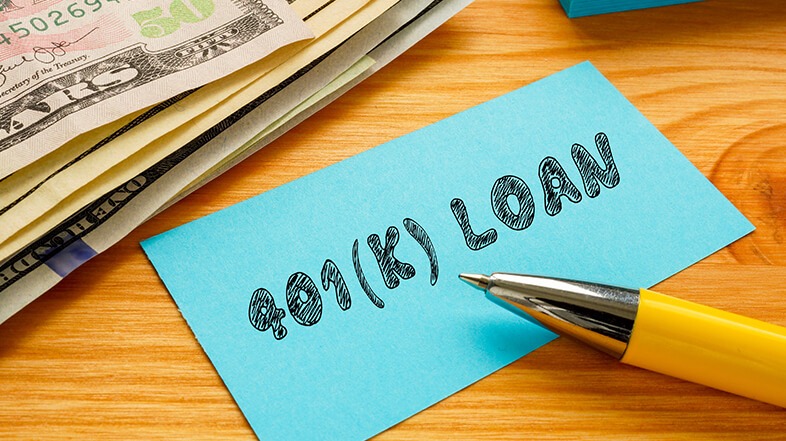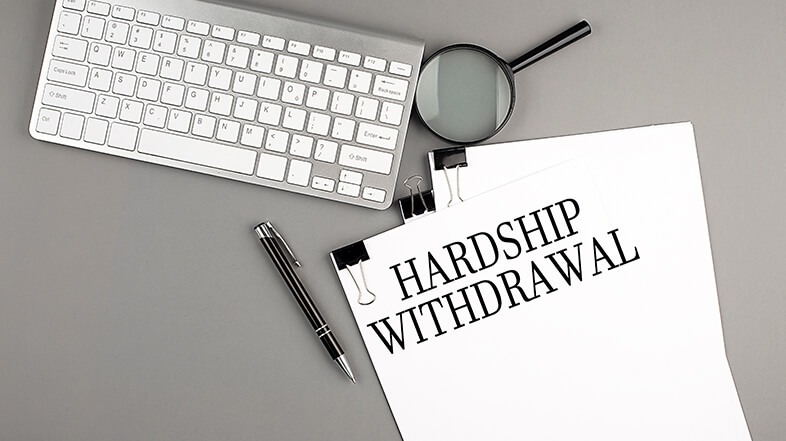
While data shows more people are saving for the future, others are putting their financial futures at risk by taking 401(k) hardship withdrawals.
401(k) hardship withdrawals should be a last resort, but people are playing fast and loose with their retirement savings, as shown by recent reports from Vanguard, Bank of America, and Fidelity.
According to Bank of America:
- Roughly 15,950 participants took hardship distributions in the second quarter of 2023, up 36% from 2022.
- The average participant hardship amount is $5,050.¹
Vanguard’s How America Saves 2023 Report claims, “In 2021, overall hardship withdrawal activity reverted to pre-pandemic levels from 2019, and in 2022, hardship withdrawal activity increased to a new high.”²
Vanguard reports that 2.8% of participants took a 401(k) hardship withdrawal in 2022, up from 2.1% in 2021.³
Additionally, Vanguard reports that 3.6% of participants took a non-hardship 401(k) withdrawal.⁴
The ability to take a withdrawal from your 401(k) plan may seem appealing – especially if you are facing a financial emergency.
However, a 401(k) hardship withdrawal may cost you more than you think.
401(k) Hardship Withdrawals Qualifications

In order to withdraw from your 401(k), you must be at least 59½ to avoid paying an early withdrawal penalty.
That is unless you qualify for a hardship withdrawal.
The IRS explains, “A hardship distribution is a withdrawal from a participant’s elective deferral account made because of an immediate and heavy financial need, and limited to the amount necessary to satisfy that financial need. The money is taxed to the participant and is not paid back to the borrower’s account.”⁵
However, not just anyone qualifies for a 401(k) hardship withdrawal.
First, your individual 401(k) plan must allow for it, which is likely as Vanguard reports that 95% of plans offer hardship withdrawals.⁶
Next, you must prove you have a financial need that is considered “an immediate and heavy financial need” for any of the following:
- Medical care expenses for the employee, the employee’s spouse, dependents or beneficiary.
- Costs directly related to the purchase of an employee’s principal residence (excluding mortgage payments).
- Tuition, related educational fees, and room and board expenses for the next 12 months of postsecondary education for the employee or the employee’s spouse, children, dependents, or beneficiary.
- Payments necessary to prevent the eviction of the employee from the employee’s principal residence or foreclosure on the mortgage on that residence.
- Funeral expenses for the employee, the employee’s spouse, children, dependents, or beneficiary.
- Certain expenses to repair damage to the employee’s principal residence.⁷
Now that most plans offer hardship withdrawal as an option, it may seem like an easier way to alleviate financial stress.
Given that many Americans are strained financially, it is not too surprising to see an increase in these 401(k) hardship withdrawals.
According to Vanguard, “In 2022, 36% of hardship withdrawals were used to avoid a home foreclosure or eviction, up from 31% of withdrawals in 2021. The second most common reason was medical expenses, as 1 in 3 hardship withdrawals were initiated for this purpose, in line with 2021.”⁸
The Difference between a 401(k) Loan and a 401(k) Hardship Withdrawal

It’s important to note that we’ve been discussing 401(k) hardship withdrawals and not 401(k) loans.
Both allow plan participants to withdraw money from their 401(k)s, but they work very differently.
A 401(k) loan is meant to be paid back, whereas a 401(k) hardship withdrawal is simply withdrawing money from your retirement savings. And since you are withdrawing money from your retirement savings, you will be taxed on the money withdrawn and face possible penalties.
In contrast, a 401(k) loan essentially allows participants to borrow from themselves and then pay themselves back with interest, without having to pay penalties or taxes on the amount borrowed as long as it is paid back on time.
While a 401(k) loan might sound like a better way to get the money you need, investors should not rush to take a loan.
There are downsides that – if you aren’t aware of upfront – could cost you way more than you planned.
[Related Read: The Downside of 401(k) Loans: Investors Beware]
The Immediate Cost of a 401(k) Hardship Withdrawal

When facing mounting medical bills or possible foreclosure, it’s tempting to seek a 401(k) hardship withdrawal.
But this money is not actually available immediately.
It can take weeks for the money to leave your 401(k).
If you need cash immediately, a 401(k) hardship withdrawal may not help you.
It’s also important to understand that, unlike 401(k) loans, you must pay taxes on the amount withdrawn from your 401(k).
Let’s say you take a 401(k) hardship withdrawal because you are cash-strapped, but because of the tax implications, you wind up paying more in the end.
Moreover, if you take an early 401(k) withdrawal that does not qualify as a “hardship withdrawal,” you may have to pay penalties in addition to taxes.
The Future Cost of a 401(k) Hardship Withdrawal

In addition to having to pay taxes and possible penalties in the immediate future, there are costs down the road.
When you withdraw money from your savings, you are left with less savings.
A 401(k) withdrawal is not a loan. You are not paying it back. You are simply taking money away from your retirement.
According to the Center for Retirement Research at Boston College, early withdrawals reduce overall 401(k) assets for retirement by 25% on average.⁹
In addition to paying taxes and possible penalties on the amount, you are also losing out on the power of compound returns.
Research conducted by Employee Benefit Adviser shows, “A hypothetical 30-year-old participant who cashes out a 401(k) savings balance of $5,000 today would forfeit up to $52,000 in earnings the sum would have accrued for them by age 65, if we assume the account would have grown by 7% per annum.”¹⁰
That’s a lot of money you’ll miss out on come retirement.
A 401(k) Hardship Withdrawal Should Be a Last Resort

If you are desperate for money, a 401(k) hardship withdrawal should still be your last resort.
Don’t put your retirement savings at risk.
Instead, consider one of these alternatives:
- Use HSA savings to cover medical expenses.
- Consider financing specifically designed for medical needs, such as CareCredit.
- Tap into other savings accounts, such as emergency savings.
- Apply for a 0% credit card, pay with it, and then pay it off interest-free before the promotional period ends.
- Take out a personal loan.
- Use your home equity line of credit.
- Ask a family member for a loan.
Before you make any major financial decisions, especially those involving your retirement savings, it is important to speak with a financial advisor.
Better Prepare for a Life of Abundance in Retirement.
Check us out on YouTube.
SOURCES
- https://business.bofa.com/content/dam/flagship/workplace-benefits/id20_0905/documents/Participant-Pulse.pdf
- https://institutional.vanguard.com/content/dam/inst/iig-transformation/has/2023/pdf/has-insights/how-america-saves-report-2023.pdf
- https://institutional.vanguard.com/content/dam/inst/iig-transformation/has/2023/pdf/has-insights/how-america-saves-report-2023.pdf
- https://institutional.vanguard.com/content/dam/inst/iig-transformation/has/2023/pdf/has-insights/how-america-saves-report-2023.pdf
- https://www.irs.gov/retirement-plans/hardships-early-withdrawals-and-loans
- https://institutional.vanguard.com/content/dam/inst/iig-transformation/has/2023/pdf/has-insights/how-america-saves-report-2023.pdf
- https://www.irs.gov/retirement-plans/plan-participant-employee/retirement-topics-hardship-distributions
- https://institutional.vanguard.com/content/dam/inst/iig-transformation/has/2023/pdf/has-insights/how-america-saves-report-2023.pdf
- http://crr.bc.edu/wp-content/uploads/2015/01/IB_15-2.pdf
- https://www.benefitnews.com/advisers/opinion/to-show-participants-you-care-help-them-avoid-401k-cash-outs
.fb-background-color {
background: !important;
}
.fb_iframe_widget_fluid_desktop iframe {
width: 1100px !important;
}




Check us out on YouTube.
background: !important;
}
.fb_iframe_widget_fluid_desktop iframe {
width: 1100px !important;
}















